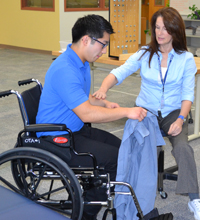What is Occupational Therapy?
Occupational Therapy is treatment to help people live as independently as possible. Occupational therapists work with people of all ages who, because of illness, injury, developmental delays, or psychological problems, need assistance in learning skills to help them lead independent, productive, and satisfying lives. Occupational therapists use work, self-care, and recreational activities to increase independent function.

Occupational Therapy can include:
- Assistance and training in performing daily activities. Depending on your needs,
these could be:
|
- Physical exercises, to increase good posture and joint motion as well as overall strength and flexibility.
- Instruction in protecting your joints and conserving your energy.
- Evaluation of your daily living needs and assessment of your home and work environments. Including recommendations for changes in those environments that will help you continue your activities.
- Assessment and training in the use of assistive devices. Examples are special key-holders for people who have stiff hands, computer-aided adaptive equipment, and wheelchairs.
- Fitting splints or braces.
- Guidance for family members and caregivers. Examples of the many different conditions and situations in which occupational therapy can help include:
|
Comprehensive Evaluation
After receiving your doctor's order, the Occupational Therapist will complete a Comprehensive Evaluation of your:
|
|

Treatment Program
Your Occupational Therapist will develop an unique, individual Treatment Program that may include:
- Range of motion exercises
- Strengthening exercises
- Exercises, massage and or use of modalities to decrease pain and swelling
- Splinting to support your injury
- Wound and skin care
- Workstation assessment/ job site evaluations
- Functional ergonomics
Treatment will also include education about the cause and anatomy of your injury, and often includes continuation of a home program to continue your progress. Finally, your participation in your treatment will bring about the best result.
Contact us if you feel you may have questions about Occupational Therapy - call 419-566-6451.






